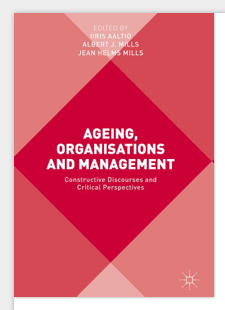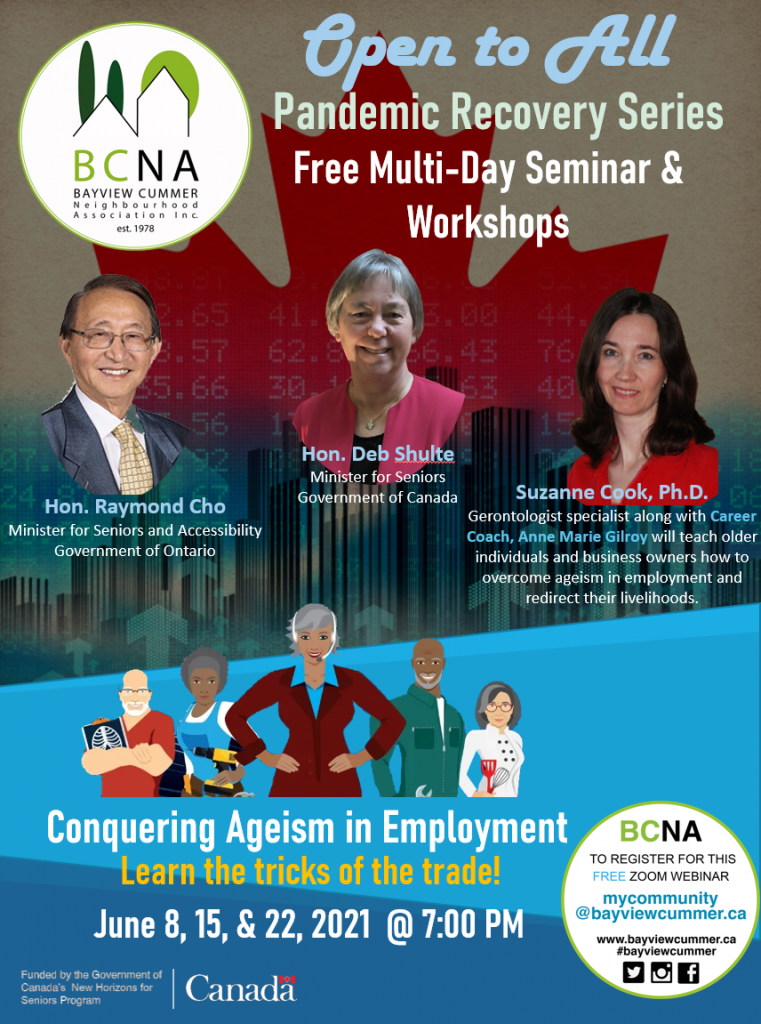Workshop Series
Posted by suzanne on Jun 7, 2021
It is exciting to share that a new workshop series is beginning June 8th, 2021. The series is entitled Pandemic Recovery Series Conquering Ageism in Employment and is hosted by the Bayview Cummer Neighbourhood Association (BCNA). It will assist mature workers who are looking for work and seeking a meaningful challenge.
Career Coach Ann Marie Gilroy and I are co-leading the series. It runs June 8th, 15th, and 22nd. It is free to attend.
Pre-register through this link: https://us02web.zoom.us/meeting/register/tZAsdemsrD8oHNfyC0GO44V5lklKB7mrRZTB
For more information visit: http://www.suzannecook.ca/workshops/

Category: Active Engagement, Aging, Aging Population, Aging Workforce, Business, Career, Economic Issues, Health and Wellness, Intergenerational, Lifelong Learning, Longevity, New Retirement, Redirection, Relationships, Social Participation, Social Policy, The Redirection Project, Vital Engagement, Work
 Post Tagged with Ageism, Aging Labour Force, Aging Population, Community, Documentary Film, Elderhood, Employment, Engagement, Experienced Workers, Finance and Economics, Income and Lifestyle, Intergenerational, Later Life Work, Mature Workforce, Meaningful-Later-Life-Work, Narrative, New Retirement, Older Workers, Redirection, Redirection Project, Skills, Storytelling, Well-being
Post Tagged with Ageism, Aging Labour Force, Aging Population, Community, Documentary Film, Elderhood, Employment, Engagement, Experienced Workers, Finance and Economics, Income and Lifestyle, Intergenerational, Later Life Work, Mature Workforce, Meaningful-Later-Life-Work, Narrative, New Retirement, Older Workers, Redirection, Redirection Project, Skills, Storytelling, Well-being Mature Workers and Technology
Posted by suzanne on Dec 27, 2020
Baby Boomers are embracing and using technology during the pandemic. Digital technology makes life easier and helps us manage daily activities better during Covid-19.
Not only are Boomers using technology. A new study indicates that Boomers have adopted innovative and time saving technologies such as virtual medical appointments and curbside pick up at a rapid pace compared to pre-Covid. These findings can help change perceptions about Boomers ignoring technological innovation being slow to accept new technology. The findings prove that Boomers are using technology and adapting their lives.
Innovation happens quickly and it is true that the digital technology available today was not available a couple of decades ago. Nevertheless, it is important to recognize that Baby Boomers are the generation who had to adapt to rapid technological change as computers entered the workplace. The reality is that technological advances were made across all industries impacting Boomers and their work.
This survey indicates that Boomers are adopting new technology faster than expected. Good on them for proving people wrong!

Category: Aging Population, Business, Lifelong Learning, Research
Aging Workforce and Policy
Posted by suzanne on Nov 28, 2020
I think it is timely to repost this blog from a few years ago. These key issues remain.
The population is aging in Canada as the baby boomer generation approaches and enters their later years. In a similar vein, the Canadian labour force is aging.
The aging population and labour force affect the Canadian economy. Policy makers, economists and government are concerned about how this will impact the economy.
Canada’s population growth is dependent upon the fertility rate, death rate and rate of immigration. Fertility rates have decreased over the decades as women have fewer children. Canadians are living longer. Immigration policy in Canada aims to bring more people into the country who can contribute to productivity and growth and compensation for the low fertility rate to keep the economy strong.
However, government, policy makers and economists do not fully recognize that older workers are eager to work and continue to work, in order to contribute to their communities. Older workers are skilled and experienced workers. They have communication, interpersonal and problem solving skills and have developed their ability to work with others. All of these skills are essential in the workplace today.
Organizational Level
As the populations ages and the workforce becomes older, all levels of society are impacted by demographic change. Importantly, this impacts organizations who are worried about a chronic labour shortage resulting from a rapidly aging population. Organizations have identified skill shortages in different roles across various industries. This is a top priority for business leaders.
Around the globe, other countries are innovating to address these concerns. These countries believe that the best way to adopt a successful aging strategy is to realize that aging is an opportunity.
One example is Japan, where policy makers have been steering the growing number of healthy 60- and 70 year olds away from retirement into work. These mature workers are taking on work roles and this makes them productive members of society. They hold jobs ”that otherwise would be impossible to fill as the population shrinks.”1
Furthermore, an entrepreneurial focus on the aging demographic, with products and services to support aging, ensures that aging is a benefit that broader society can reap.
Although consumer spending growth overall is weak in Japan, economists at UBS Securities there say they believe the expansion of the senior market could more than offset any declines that come from a shrinking population, at least for a time.2
For Japan, the way forward is clear. For more, visit Aging Gracefully in the Wall Street Journal.
Footnotes:
1 Schlesinger, J. M. & Martin, A. (2015). Entrepreneurs are exploring robotics and other innovations to unleash the potential of the elderly. Aging Gracefully: Graying Japan Tries To Embrace the Golden Years.
2 Ibid.
Talent Management and Later Life Career
Posted by suzanne on Sep 30, 2017

Talent Management and Career Development of Older Workers: I discuss this in Chapter 6 of this new book.
The workforce is aging. This is a critical business issue and organizations are paying closer attention.
With this new demographic shift in the workplace, the talent management and career development of mature workers must be redesigned. These are two new emerging and interconnected issues that are discussed in my latest book chapter.
I co-authored Talent Management and Older Workers: Later Life Career Development, Chapter 6 of Ageing, Organisations and Management, with Victoria Rougette (see pages 113 – 140). Here is a short description of the chapter:
“The Canadian workforce is ageing and there is greater labor force participation among older adults. These unprecedented shifts require business and industry to examine the talent management of older workers while considering their career development. In fact, a top strategic issue facing organisations is the talent management of the ageing workforce such as the recruitment, retention, training and development, and career progression of older workers. This chapter examines the career development of older workers and talent management policy in organisations through a critical lens in order to shift the discourse surrounding work and ageing. This approach can support the labor force participation of older workers and their career development needs while also strengthening talent management within organisations.”
The new book, Ageing, Organisations and Management, edited by I. Aaltio, J. Helm Mills and A. Mills and published by Palgrave Macmillan, is now available.
This edited book examines business, organizations and work with a focus on aging. The chapters are written by scholars from Europe, North America and Australia. Other chapters are entitled: Age Management in Organizations: The Perspective of Middle-Aged Employees; Reifying Age-Related Employment Problems Through the Constructions of the “Problematic” Older and Younger Worker; and Old Age as a Market Advantage: The Example of Staffing Agencies in Sweden.

Category: Aging, Aging Workforce, Business, Career, Economic Issues, Work
Older Workforce, Aging Consumers
Posted by suzanne on Feb 10, 2017
The population is aging in Canada as the baby boomer generation approaches and enters their later years. In a similar vein, the Canadian labour force is aging.
The aging population and labour force affect the Canadian economy. Policy makers, economists and government are concerned about how this will impact the economy.
Canada’s population growth is dependent upon the fertility rate, death rate and rate of immigration. Fertility rates have decreased over the decades as women have fewer children. Canadians are living longer. Immigration policy in Canada aims to bring more people into the country who can contribute to productivity and growth and compensation for the low fertility rate to keep the economy strong.
However, government, policy makers and economists do not fully recognize that older workers are eager to work and continue to work, in order to contribute to their communities. Older workers are skilled and experienced workers. They have communication, interpersonal and problem solving skills and have developed their ability to work with others. All of these skills are essential in the workplace today.
Organizational Level
As the populations ages and the workforce becomes older, all levels of society are impacted by demographic change. Importantly, this impacts organizations who are worried about a chronic labour shortage resulting from a rapidly aging population. Organizations have identified skill shortages in different roles across various industries. This is a top priority for business leaders.
Around the globe, other countries are innovating to address these concerns. These countries believe that the best way to adopt a successful aging strategy is to realize that aging is an opportunity.
One example is Japan, where policy makers have been steering the growing number of healthy 60- and 70 year olds away from retirement into work. These mature workers are taking on work roles and this makes them productive members of society. They hold jobs ”that otherwise would be impossible to fill as the population shrinks.” 1
Furthermore, an entrepreneurial focus on the aging demographic, with products and services to support aging, ensures that aging is a benefit that broader society can reap.
Although consumer spending growth overall is weak in Japan, economists at UBS Securities there say they believe the expansion of the senior market could more than offset any declines that come from a shrinking population, at least for a time.2
For Japan, the way forward is clear. For more, visit Aging Gracefully in the Wall Street Journal.
Footnotes:
1,2Schlesinger, J. M. & Martin, A. (2015). Entrepreneurs are exploring robotics and other innovations to unleash the potential of the elderly. Aging Gracefully: Graying Japan Tries To Embrace the Golden Years.

Category: Aging, Aging Population, Aging Workforce, Business, Economic Issues, Longevity, Services for Seniors, Social Policy, Work
 Post Tagged with Aging Labour Force, Aging Population, Employment, Finance and Economics, Mature Workers, Mature Workforce
Post Tagged with Aging Labour Force, Aging Population, Employment, Finance and Economics, Mature Workers, Mature Workforce 





